Waterloo Battlefield, Braine-l’Alleud, Walloon Brabant, Belgium (1993, 1998)
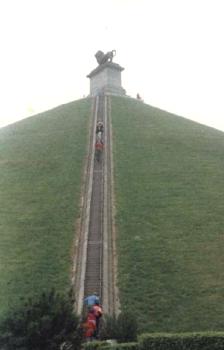
A great battle raged on June 18, 1815 just south of Brussels, Belgium near Braine-l’Alleud and Waterloo (map). The Duke of Wellington commanding allied troops from several nations defeated Napoleon Bonaparte and his fearsome army after a punishing eight-hour conflict. Historians recognize this as one of the monumental battles of European history. It marked the final defeat for the emperor Napoleon and his dreams of conquest after his return from Elba.
This location might hold a special meaning my family. One version of a family legend claims my 3gr.-grandfather fought on the English side and received a saber wound in combat. Who can say if it’s really true? Nonetheless it felt strange to stand in the same location where a family member may have stood in battle two centuries earlier.
The King of the Netherlands commissioned the construction of this large conical earthwork between 1823 and 1826. He designated it as a tribute to his son, the Prince of Orange. It marked the center of British forces and the approximate spot where the Prince suffered a gunshot wound to his shoulder during the conflict.
Climbing Up
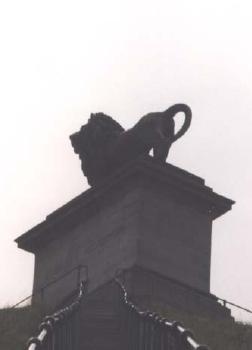
Getting to the top of the Butte du Lion required a climb of 226 steeply angled steps straight up the side of the earthen cone. Legs began to ache even with nearby railings to steady oneself on either side. The stairwell didn’t any landings along the way for intermediary resting places. However, visitors coming up and down used the same narrow staircase. Thus we found several opportunities to take a break while allowing others to pass from the opposite direction.
The top of the hillock rose more than 140 feet above the battlefield with a base circumference measuring a third of a mile. Think about the amount of dirt that needed to be moved to create this mound. No wonder it took three years to construct. People considered it an engineering marvel at the time.
The Lion
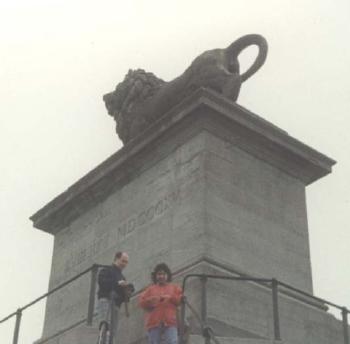
Coming closer to the top of the summit we could better read the inscription on the base of the statue. It said “XVIII JUNI MDCCCXV,” the Latin version of the decisive battle date, 18 June 1815. We heard that the great weight of the pedestal and statue required a brick pylon to be built through the entire center of the cone. It extended from the bottom of the pedestal all the way down to the bedrock below. I can’t confirm this. Unfortunately, I don’t think anyone can dig down and prove it either, so I’ll take their word for it.
Just the lion itself weighs 28 tons. Sculptors created the figure in cast iron. Then they transported it to the site by barge and carted it in pieces by wagons pulled by teams of 20 horses to be assembled on location. The coat of arms of the monarch of the Netherlands included a lion so it became a good choice. Additionally it symbolizes bravery and courage. Its front paw rests on a sphere, representing the sweeping global victory attained in this pivotal battle.
Notice the people in this photograph wearing jackets. I took this photograph in June. While I’ve seen lots of picture-perfect postcard images of the Butte du Lion, this may be a more accurate rendition of what sightseers should actually expect on a typical visit.
The Battlefield
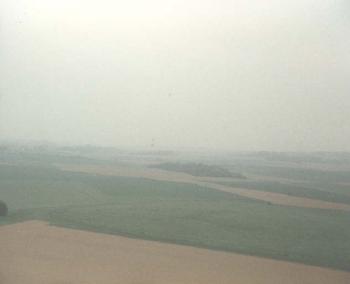
We surveyed the battlefield and the surrounding countryside from the top of the Butte du Lion. More than 300,000 soldiers clashed here on that June day in 1815. Within a few hours nearly 10,000 men died, with 30,000 wounded, and Napoleon’s aggressions crushed.
Wellington’s Anglo-Dutch forces withstood an attack then a counterattack. Prussia’s Gebhard von Blücher came onto the field as Wellington’s center continued to hold, and smashed into Napoleon’s flank. The French front disintegrated and a retreat became a route. Wellington and Blucher advanced on Paris. Napoleon abdicated less than a week later on June 24. Then he spent the rest of his days exiled on Saint Helena.
I have a photograph of this same patch of the battlefield taken in 1998 with conditions apparently even more overcast. I could identify the location by that dark green patch of plants near the center of the photo. It’s probably a rock outcrop unsuitable for farming that has been overgrown by scrub vegetation.
Panorama
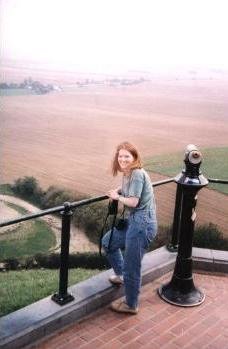
The brick landing that circled the statue pedestal provided 360-degree views of the entire battlefield. Notice the little spyglasses mounted at various points around the circumference. I’m sure visitors could see far off into the distance on a clear day.
The one thing to keep in mind is that even though the battlefield remains a rural island free of modern clutter, it is not exactly the way it appeared in 1815. Ironically, many of the significant military features of the battlefield had to scraped away to pile enough dirt to build the Butte du Lion. Nonetheless it’s still a great view and worthy of a breathless climb.

Leave a Reply